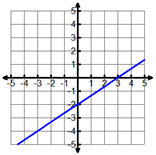For this section of the lesson, you will explore characteristics of the graph of a quadratic function if the equation is written in vertex form.
Vertex Form: y = a(x − h)2 + k
Investigating the Vertex Form of a Quadratic Equation
- Click on the link below to access the applet. Investigate the vertex form of a quadratic equation.
- Use the scroll bar in the applet to slide the values of a, h, and k. Observe how these values change the parabola.

 Role of a, h and k in y = a (x - h)2+ k
Role of a, h and k in y = a (x - h)2+ k
- How did a affect the graph? Once you have formulated a conjecture, complete the following statements.
- If a < 0 (or negative), then the parabola . . .
Interactive popup. Assistance may be required.
Check Your Answer
- If a > 0 (or positive), then the parabola . . .
Interactive popup. Assistance may be required.
Check Your Answer
- Record what you observe.
- What other observations did you make?
- How did h and k affect the graph?
Name the Vertex for the Following Quadratic Functions
- y = (x − 2)2 + 6
-
y = - 2(x + 5)2 + 4
- y = - (x − 3)2 + 1
Complete the following statement. (Click or touch the blanks to see the correct answers.)
When the equation of a quadratic function is written in vertex form: y = a(x − h)2 + k, the
Interactive button. Assistance may be required.
__________
vertex
can easily be identified by
Interactive button. Assistance may be required.
__________
(h,k)
.
Axis of Symmetry
In previous lesson, we learned that the axis of symmetry runs down the center of the parabola through the vertex.
Therefore the axis of symmetry for equation 1 is x = 2. (Remember that 2 is the x-coordinate of the vertex.)
Steps to Find the y-intercept of a Quadratic Function Written in Vertex Form
Do you remember how you found the y-intercept of a linear function?
Interactive popup. Assistance may be required.
Quick Recap
Since the y-intercept of a quadratic function also has an x-value of 0, you will use the same process.
Example
y = ½(x − 2)2 + 6
y = ½(0 − 2)2 + 6
y = ½(-2)2 + 6
y = 8
y-intercept is (0 ,8)
Now, let’s put all the characteristics together to determine each part of the parabola.
I'll do this one.
You do this one.
y = 2(x − 3)2 –10
y = -3(x + 1)2 + 7


Since a > 0, I know the parabola is facing up.


The vertex is (3, -10) since (h, k) represents the vertex.


The axis of symmetry is x = 3 since the x-coordinate of the vertex is 3.
y = 2(0 − 3)2 − 10
y = 2(-3)2 – 10
y = 8
The y-intercept is (0, 8).


To find the y-intercept, I will substitute 0 in for x and solve for y.


Since a = 2, I also know that the graph is facing up and has a vertical stretch of 2.



